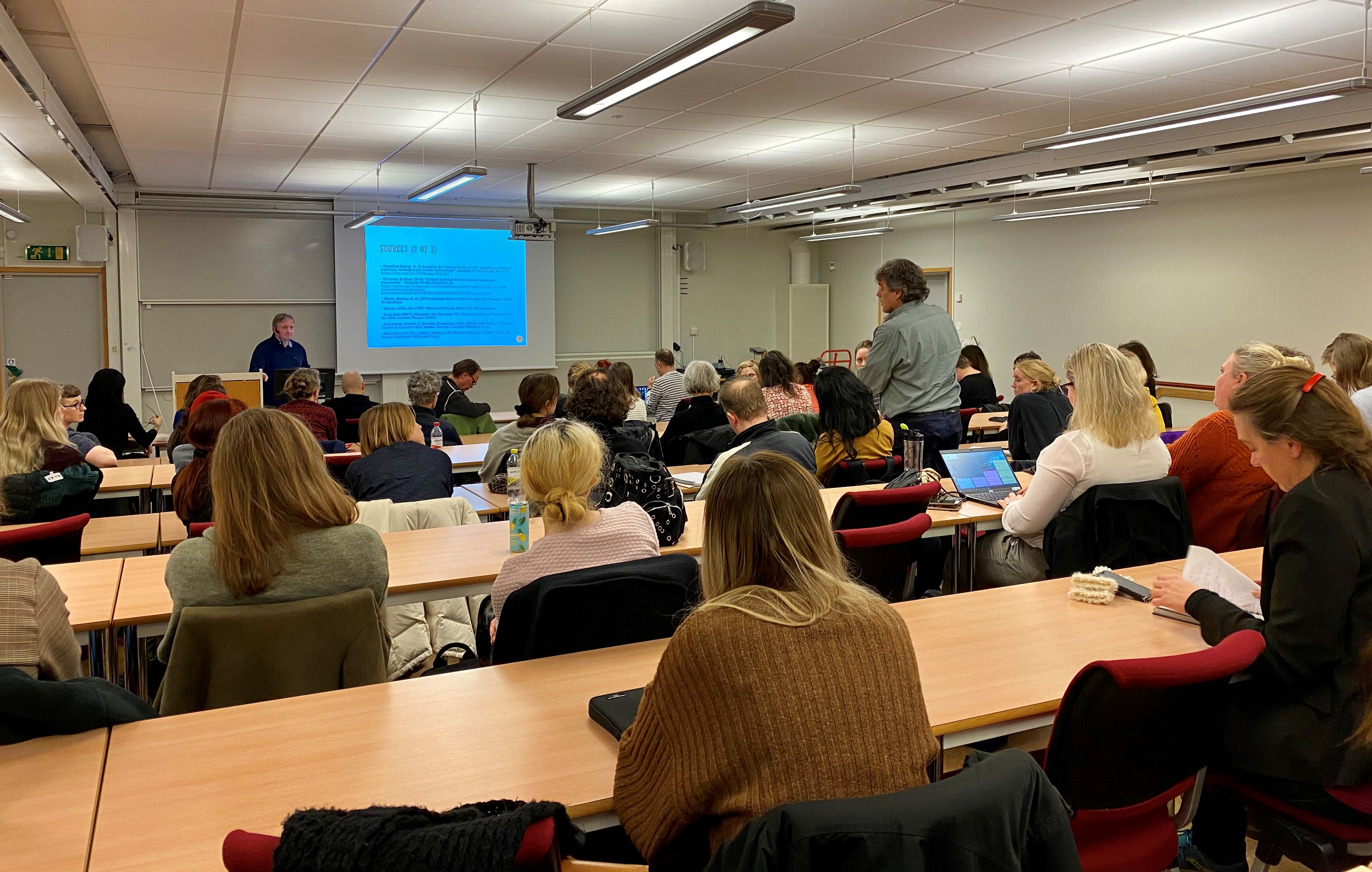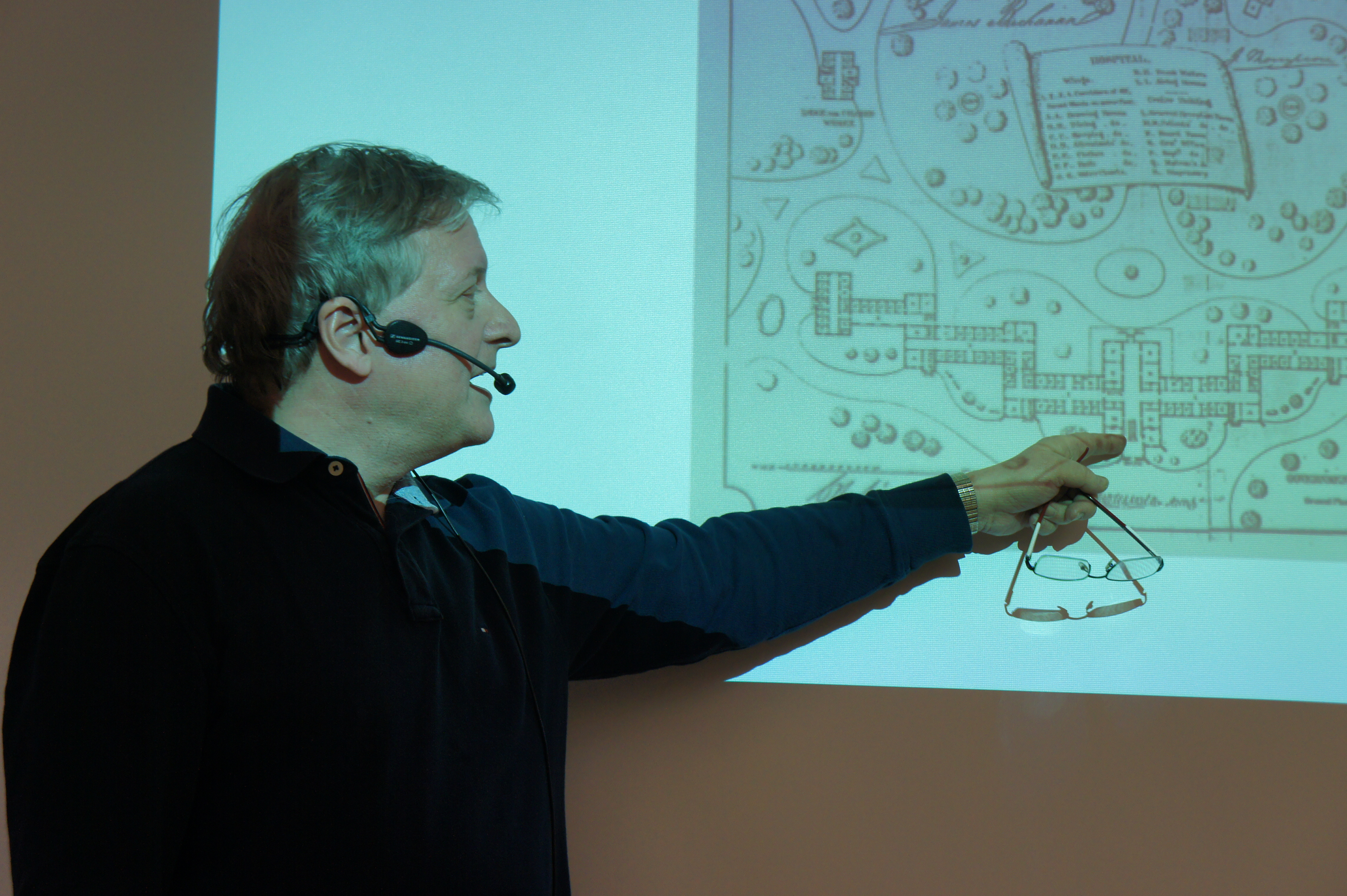- Home
- News and events
- Find news
- Mad studies meets critical heritage studies
Mad studies meets critical heritage studies
Geoffrey Reaume is one of the front figures in Mad studies - an interdisciplinary field where clinicians, researchers, ex-patients, users, artists and relatives work together to understand mental distress. On February 18th Reaume held a public lecture Mad people’s history, mad studies and critical heritage studies and it attracted nearly 80 people.

Geoffrey Reaume has been guest researcher at CCHS/Heritage and Wellbeing and the Department of Social Work at the University of Gothenburg during February. Geoffrey has actively worked to bring attention to offenses committed against patients in psychiatry and that traces of patients should be regarded as cultural heritage.
Reaume emphasizes that the history and experience of psychiatric patients are rarely described. In the history writing, the physician rather than the patients are more focused upon until recently. And when patients' history is actually present, it is rarely from the view of the vast majority of poor people, or women and racialized who are categorized as having madness or mental illness.

When it comes to "mad peoples history", Reaume stressed that many people could be labelled mentally ill without actually having mental distress or who did experience madness and were abusively treated by others. It could be enough to be awkward, not to fit into society, or in Elizabeth Packard’s case be incarcerated in 1860 United States for protesting against her husband's harsh treatment of their children, disagreeing with him about religious beliefs, and because she was against slavery (unlike her husband). For this, she spent three years at the Jacksonville Insane Asylum in Illinois. When she was able to get out of there, she was in legal conflict with her husband, which resulted in her being acquitted of madness. Packard then spent the rest of her life fighting for women's rights, freedom of expression and rights of people accused of insanity.
Reaume points out that Mad studies works from a bottom-up perspective, which can also be compared to several approaches within critical heritage studies.
– It's about making previously unseen stories visible, and remembering narratives that have been forgotten and hidden, says Reaume.
Lasse Mattila listened to Reaume’s lecture. Mattila is a social worker that started Föreningen Alternativ till Psykofarmaka, FAP (Association for Alternatives to Psychopharmaceuticals), and runs a website called Mad in Sweden.
– Lasse, what does Geoffrey's and others' work mean to you and the members of the association?
– It was incredibly inspiring to listen to someone who has immersed himself in a subject that has such a large part in one's own everyday life and in one's own work. Raising the patient perspective is important overall, and there are so many stories to be told even in Sweden, says Lasse Mattila.
Not only has patients' history been treated differently depending on people’s background, but also their treatment and their placement in the hospitals. Reaume described how departments were, at different times in the past, divided according to colored women, colored men, white women, white men, etc. Thus "mad peoples history" can also be described as histories of racialized people. It is also a story of unpaid labor - the female patients often worked as domestic workers, washers and seamstresses in hospitals or in staff hosing. It was often years of exploited labor.

Workshop and seminar on Mad Heritage
The workshop Mad Heritage held on the 19th focused on issues about remembering and making the silenced voices and lives of patients heard. Reaume discussed the work concerning the former asylum Toronto hospital for the insane now known as Toronto’s Centre for Addiction and Mental Health where he and others worked to commemorate a memorial wall with plaques in remembrance of former patient laborers. The wall around the mental hospital was said to be built by unknown persons, but Reaume's research has shown that unpaid patients built it.
An association named "Mad Heritage and Contemporary Arts" has been established in Gothenburg by clinicians, researchers, users of mental health services, and artists. The association will work for remembrance of patients’ past through seminars, exhibitions and a website. They have also initiated dialogues with representatives from former mental health institution Lillhagen in order to remember patients and preserve the artwork that decorate the walls of the tunnels under the former hospital and are made by former patients. During the workshop Geoffrey Reaume shared his experiences of working for remembrance and preservation and gave some good suggestions to the participants.
At the Department of Historical studies, Geoffrey held a seminar on February 20th named Teaching and preserving mad people’s history.
– Geoffrey, how has your stay in Gothenburg been and what do you bring back home from it?
– My stay in Gothenburg was very enjoyable during which I learned a great deal from activists and academics working to preserve and commemorate Mad People’s History at Lillhagen hospital and who are also working to establish Mad Studies in Sweden.
Elisabeth Punzi and her colleagues at the University of Gothenburg, along with people from the local community, as well as visitors from Malmo, Stockholm and Uppsala were all very welcoming and generous with their time. Their sharing of information about mad and disabled people’s histories in Gothenburg and Sweden more generally provided me with a greater appreciation of the connections between Sweden and Canada regarding similar efforts to publicly commemorate and inform people about this past along with its relevance to social justice struggles today. It was an honour to be invited as a guest researcher at the University of Gothenburg where Critical Heritage Studies held a foundational conference in 2012. In the years ahead, I look forward to continued collaboration with people whom I met in Gothenburg who are working on Mad People’s History, Mad Studies and Critical Heritage Studies.
Continued work on the heritage of psychiatry
– Elisabeth, what do the plans look like for research and collaboration on the heritage of psychiatry for the Heritage and Wellbeing cluster?
The cluster will work together with the association Mad Heritage and Contemporary Arts. We will focus on remembrance and the heritage of psychiatry and the patients as an important field. It is important to note that this is not only about remembrance. It is about recognizing abuse and injustice. It is also about acknowledging that psychiatrised persons are still exposed to abuse and injustice and we would like to contribute to change. One way of doing this is through creative expressions.
The cluster is also working with two forthcoming publication about remembrance and the importance of more humane perspectives, one called Narrating the Heritage of Psychiatry, the other Psychiatric and Disability Institutions after Deinstitutionalisation: Memory, Sites of Conscience, and Social Justice. Geoffrey Reaume is going to contribute to both.
Photos
1. From the lecture Mad people’s history, mad studies and critical heritage studies, photo by Jenny Högström Berntson
2. Geoffrey Reaume, photo by Royner Norén
3. Geoffrey Reaume, audience at the lecture, Lasse Mattila in discussion with Jenny Högström Berntson and Elisabeth Punzi, photos by Royner Norén